The Deccan states of Ancient India (300-750 AD)
The Deccan states of Ancient India (300-750 AD)
After the fall of Kushanas in the North and Satvahana in the south, several minor powers emerged, as shown in the following map:
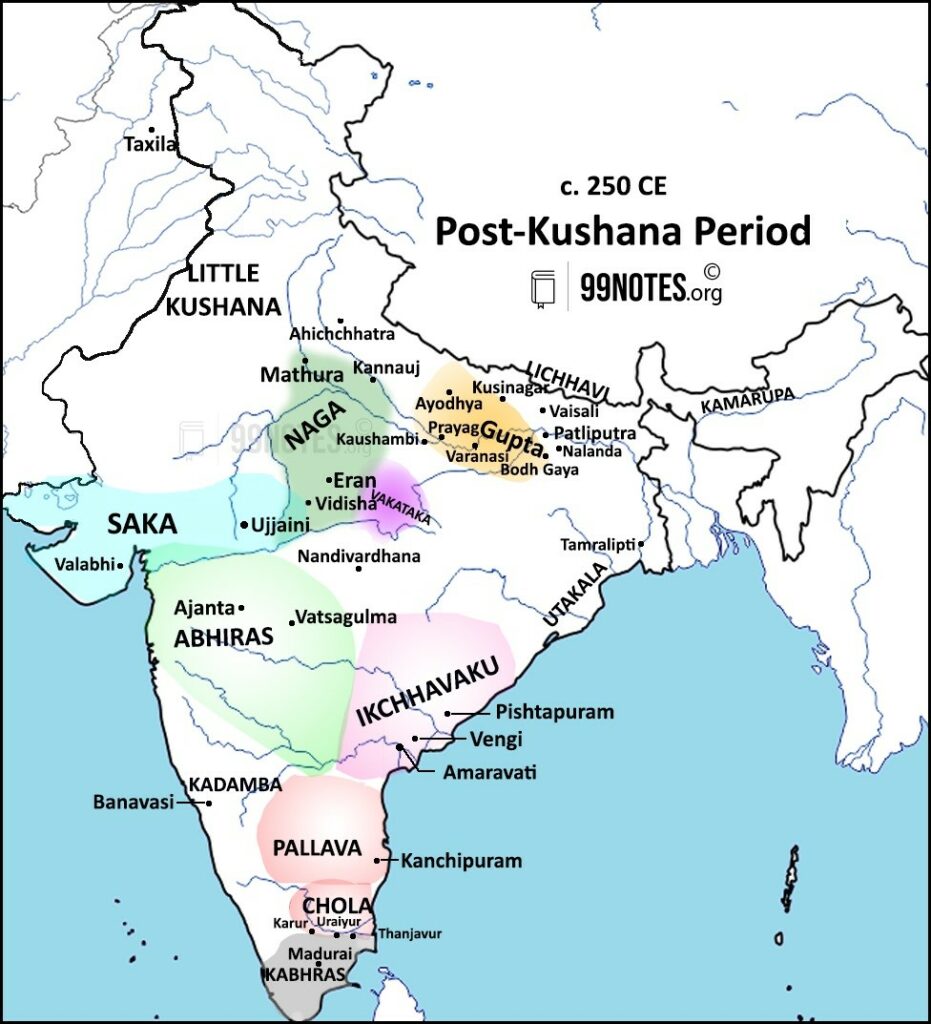
Features of this age:
- The Guptas emerged and dominated the political affairs in the north of Narmada till the 5th century CE, followed by the Pushyabhutis till the 7th century.
- Several small powers emerged in the south in quick succession. The Ikshavakus and Abhiras rose on the power vacuum left after the fall of Satvahanas. However, their rule quickly fell, and in its place, a powerful Chalukyan dynasty emerged.
- The Sangam age dynasties – Cholas, Pandyas and Cheras, were losing their control, and in their place, eventually, Pallavas rose.
Local powers in the 3rd Century Deccan India
1. The Kalabhra Reign
- After the decline of Chola, Chera and Pandya in the third century A.D., very little is known about what ensued in the Tamil land.
- The Kalabhra revolt is the only significant event in the third to sixth century CE. Kalabhras are called evil rulers in the Sangam literature who overthrew many kings and set up their rule on the Tamil land.
- Revolt directed against Brahmans:
- It seems that the revolt was directed against the prevalent social and political structure in south India.
- They put an end to the brahmdeya rights granted to the Brahmanas. However, they patronised Buddhist monasteries.
- Their reign lasted for two centuries, fading in the 6th century after the overwhelming rise of the Pallava and Chalukya kingdoms.
2. The Ikshavakus
- The Ikshavakus of Vijayapuri (Nagarjunakonda) rose on the ruins of Satavahana power in the Krishna-Guntur region of the Indian Peninsula.
- They could have been a local tribe that adopted the name of Ikshavakus to demonstrate their lineage’s antiquity.
- They started the practice of granting lands in the Krishna Guntur region, where several of their copper plate inscriptions have been found.
- The Ikshvakus were followers of the Brahmanical tradition, while at the same time, the women of the royal household came from prominent families patronising the Buddhist religion.
- The Ikshvakus themselves promoted Buddhist centres on account of the continuous trading and commercial activities in the Andhra region till about the 4th-5th centuries CE.
- Archaeological evidence from Nagarjunakonda shows both Buddhist and Brahmanical monuments (Astabhujasvamin and Puspabhadrasvamin temples), apart from Roman coins (of Hadrian).
- The Ikshvakus were supplanted by Pallavas.
The Rise of Vakatakas (4th – 5th century CE)
- In northern Maharashtra and Vidarbha, the Satvahanas were succeeded by the Vakatakas from the fourth to the sixth century CE, who were directly influenced by the changing political configuration in north India under the Guptas.
- Origins:
- Vakatakas are mentioned as Vindhyakas in Puranas, as they initially expanded in the Vindhya region.
- Vindhyashakti (250-270 CE) is considered its founder. He is described as a Dvija and a Brahman in a 5th-century inscription in the Ajanta Cave XIV by the Vakataka king Harisena’s minister Varahadeva.
- He and his son Rudrasena proved to be a formidable power. However, Samudragupta’s aggression forced them to the south of Narmada.
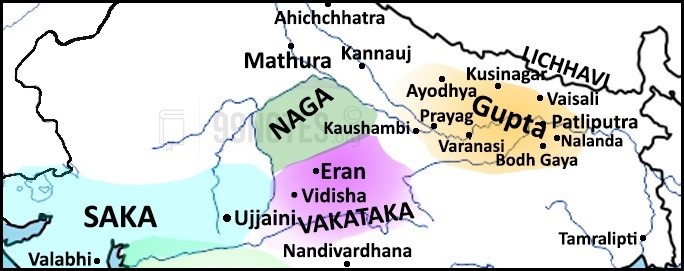
- Relations with Guptas Initially:
- The Vakataka were initially crucial rivals of the Guptas in North India. The Vakataka formed a matrimonial alliance with their rival Nagas, and the Guptas formed a matrimonial alliance with Licchavis, probably to counter each other.
- Samudragupta, however, supplanted Vakatakas from North India along with 12 rulers of Aryavrata, according to Prayag Prashasti, and took control of Vidisha.
- Vakataka expansion in the South of Narmada:
- After Samudragupta’s assault, Vakatakas escaped south and established their hold there.
- In the south, they were divided into two branches. Their core branch had its capital at Nagardhan or Nandivardhana (near Nagpur). Another branch had its capital at Vastugulma (near Ajanta).
- Relation with Chandragupta II:
- Chandragupta II married her daughter Prabhavatigupta to Vakataka king Rudrasena and got their support in his fights against Shaka Kshatrapa. This alliance also secured their territory against the Gupta aggression.
- They not only had close political ties with the Guptas but also, for the first time, introduced Gupta political structures in peninsular India.
- After the death of Rudrasena, Prabhavati acted as the Queen regent, bringing the Vakataka realm under the effective control of her father, Chandragupta II.
- Prabhavati’s son Prithvisena extended Vakataka rule from the southern edges of Gujarat and Malwa in the north to the river Tungabhadra in the south and from the Arabian Sea in the west to the edges of Chhattisgarh in the east.
- He also declared independence from the Gupta alliance.
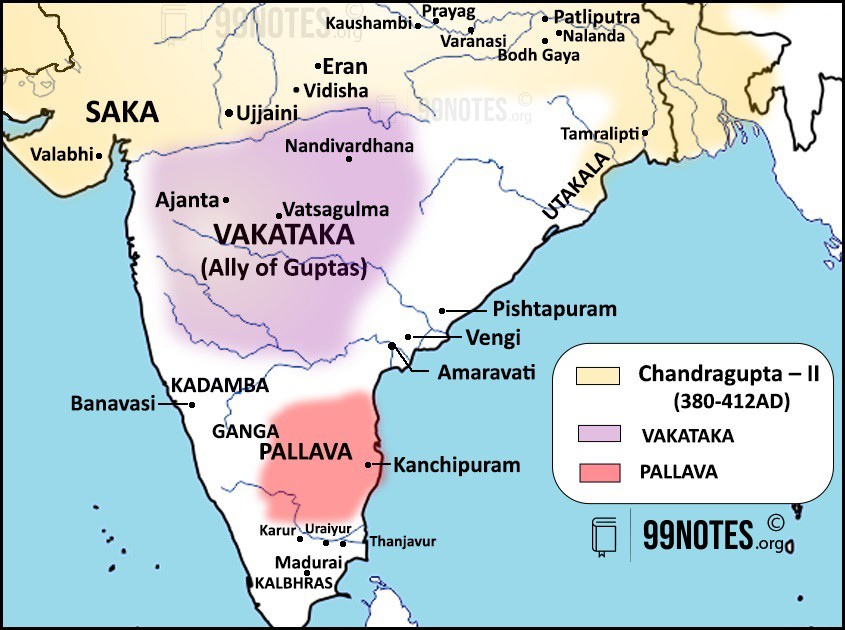
- Vakataka ruled till 510CE, reaching the peak of their territorial extent in around 480CE when they could briefly control the Krishna-Godavari delta region too. However, their decline is still a mystery and is open to debate by historians.
- The Religious attitude of Vakatakas:
- Brahmadeya Rights: Vakataka were Brahmanas and known for many copper-plate land grants to the Brahmanas.
- Culturally, the Vakatakas became a channel for transmitting Vedic ideas and social institutions to the south.
- However, Buddhism also flourished, andseveral chaityas and Viharas in Ajanta caves were built under Vakatakas.
Local powers 5th Century CE onwards
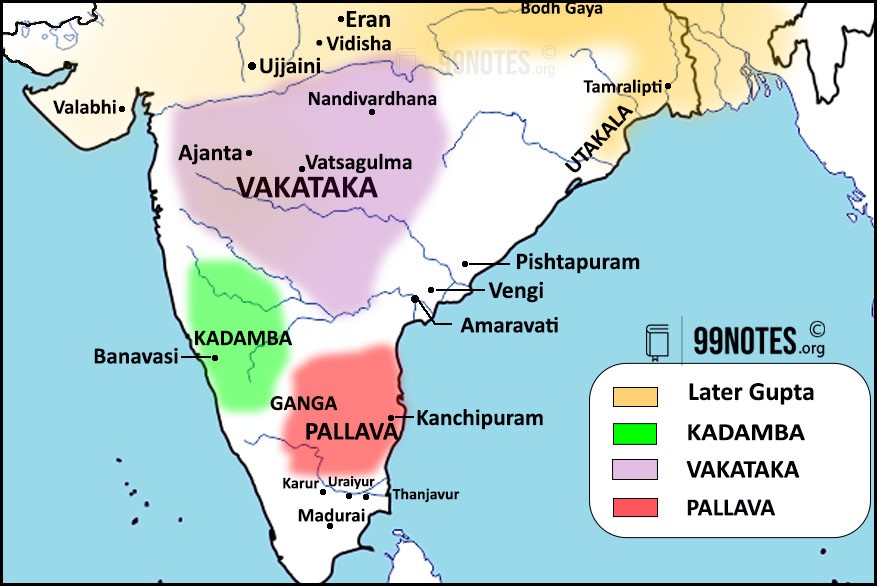
1. The Kadambas
- They established their capital at Vaijayanti or Banavasi in the North Kanara district in Karnataka.
- Mayursharman(345-365 CE) founded the Kadmaba dynasty after defeating the Pallavas with the help of forest tribes in northern Karnataka and Konkan in the 4th century.
- However, eventually, Pallava gained control but recognised the authority of Mayursharman.
- He is said to have performed eighteen Ashvamedha yajna and granted numerous villages to Brahmanas.
- Their power reached its peak in the 5th century.
2. The Gangas
- They established their rule in southern Karnataka around the 4th century. Their kingdom lay between Kadambas on the western side and the Pallavas on the eastern side. Most of the time, they were Pallava’s feudatories.
- They are called western Ganga or the Gangas of the Mysore to demarcate them from Eastern Gangas who ruled in Kalinga, starting in the fifth century.
- Their earliest capital was situated at Kolar, which may have helped the dynasty’s rise because of the gold mines.
- They made land grants mainly to Jainas.
3. The Pandyas
- The Sangam Pandyas, or early Pandyas, declined with the rise of Kalabhras in the third century. But ultimately, the Pandyas were successful in acquiring the region’s political hold.
- Kadungon established the “first Pandyan Empire” after defeating the Kalabhras in the 6th century CE. This is known as the first Pandyan Empire to distinguish it from the 13th-century Pandyan empire, which was founded by Maravarman Sundara Pandyan.
- The Pandyas ruled in the southernmost regions of Tamilnadu, and the Vagai river basin was the Heartland of the kingdom. River Kaveri acted as the border between the Pallavas and the Pandyas.
The Rise of the Chalukyas and the Pallavas (6th Century)
From the mid-6th century CE, a power struggle between the Pallavas of Kanchi and the Chalukyas of Badami dominated the political scene in the Deccan. The Pandyas of Madurai joined the conflict as a poor third.
- Pallavas rose to power in the mid-3rd century and could have initially been feudatories of Satvahanas. They ruled from Kanchipuram.
- Chalukyas could have initially been feudatories of Kadamba and rose to power in the Raichur doab. They ruled from Vatapi(Badami) and thus are called the Chalukyas of Badami to differentiate them from other branches that emerged later.
- By the end of the sixth century, both Pallavas and Chalukyas became strong kingdoms and threatened each other. This situation was aggravated due to the proximity of their two capitals.
- Although both the Pallavas and the Chalukyas promoted Brahmanism, the two quarrelled for prestige, plunder and territorial resources. They tried to establish supremacy in the Raichur doab, i.e. the land between the Krishna and the Tungabhadra.
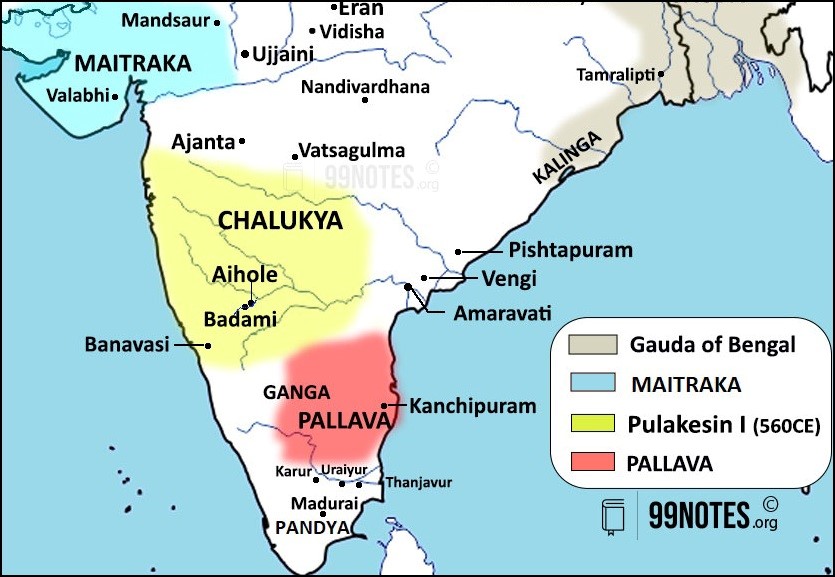
The conflict between Pallavas and Chalukyas
- In his conflict with the Pallavas, Pulkeshin II almost reached the Pallava capital during Mahendravarman I’s rule, but the Pallavas bought peace by ceding their northern provinces to him.
- Later, Pallava King Narasimhavarman-I defeated Pulkeshin -II and seized the Chalukyan capital, Badami, in 642 CE, in which Pulkeshin II was probably killed.
- Vikramaditya –I (644-681 CE) (son of Pulikeshin II) conquered Badami back from the Pallavas. He also tried to attack Kanchi but failed.
- The lull in the conflict ended in the first half of the eighteenth century when Chalukyan king Vikramaditya II (733-745 CE) is said to have overrun Kanchi three times, although he did not plunder it. He took advantage of a succession crisis and a 12-year-old Pallava king on the throne.
- Vikramaditya aimed to wipe out the disgrace brought upon his family a century ago when Pulakesin II was killed.
- His victory ended the Pallava domination in the far south.
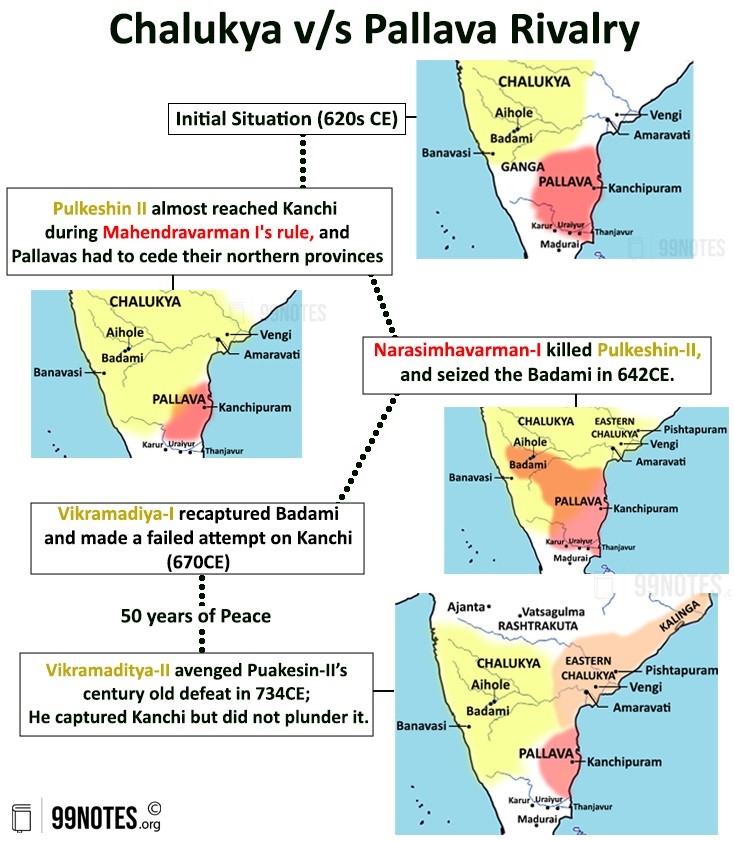
The Chalukyas
-
- The Chalukyas became the sovereign power with Pulakeshin-I in the sixth century in the western Deccan. They established Vatapi (modern Badami) as their capital.
- The Gist of the lineage of the Chalukyas of Badami:
-
- Pulakeshin II (609-642 AD) was the most famous Chalukya king.
- We know him from his eulogy in the Aihole inscription penned by the court poet Ravikirti.
- His expansions made Chalukyas the predominant power in the Deccan.
- The Western Gangas in the south and the Malavas, Latas and Gurjaras in the north submitted to him.
- He also subjugated the Kadamba capital at Banavasi.
- He conquered Vengi in the eastern Deccan and placed his brother as the governor, thereby starting the Eastern Chalukya branch of Vengi.
- His army checked the forces of Harsha Vardhana on the banks of the Narmada.
- He sent a diplomatic mission to the Persian king Khusrau II in 625CE (mentioned in Ajanta paintings).
- Pulakeshin II (609-642 AD) was the most famous Chalukya king.
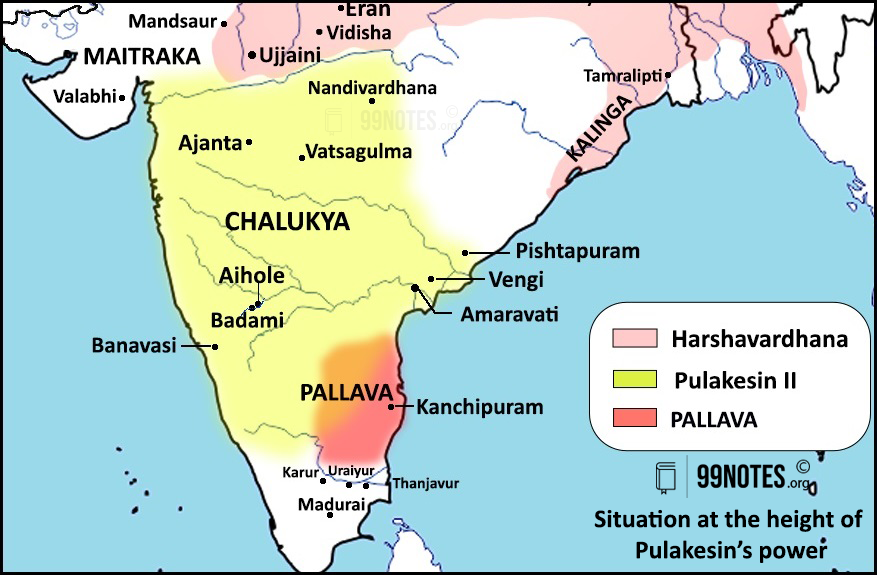
-
-
- Later they divided into several independent ruling houses, but the main branch at Vatapi continued to rule for two centuries.
- The Fall of Chalukyas: In the mid-8th century western Deccan India, the rise of the Rashtrakutas eclipsed the Chalukyas of Badami. The Rashtrakuta king, Dantidurga, defeated the last Chalukyan Ruer Kirtivarman II.
- Chalukyan descent impacted the Deccan polity for a long time:
- The Eastern Chalukyas, who initially were local feudatories of the Chalukyas of Badami, carved out an independent kingdom after the death of Pulakesin II, with Vengi as their capital. From here, they ruled until about the 11th century.
- The Western Chalukyas tried to revive themselves in the 10th and ruled from Kalyani (modern Basavakalyan) until the end of the 12th century.
- The Cultural Impact:
- Vesara architecture – in which mortar was not used, flourished during Chalukya’s rule.
- Patadakal school of temples at Aihole, now a UNESCO world heritage site, represent this style.The Ravanphadi cave depicts a fine sculpture of Ravana lifting Mount Kailasa.
- Huen Tsang reports that Buddhism was in decline in Western Deccan; however, Jainism flourished. The Pattadakal group of temples depict this reality.
- Ghatika was the centre of learning within the premises of temples in southern India.
-
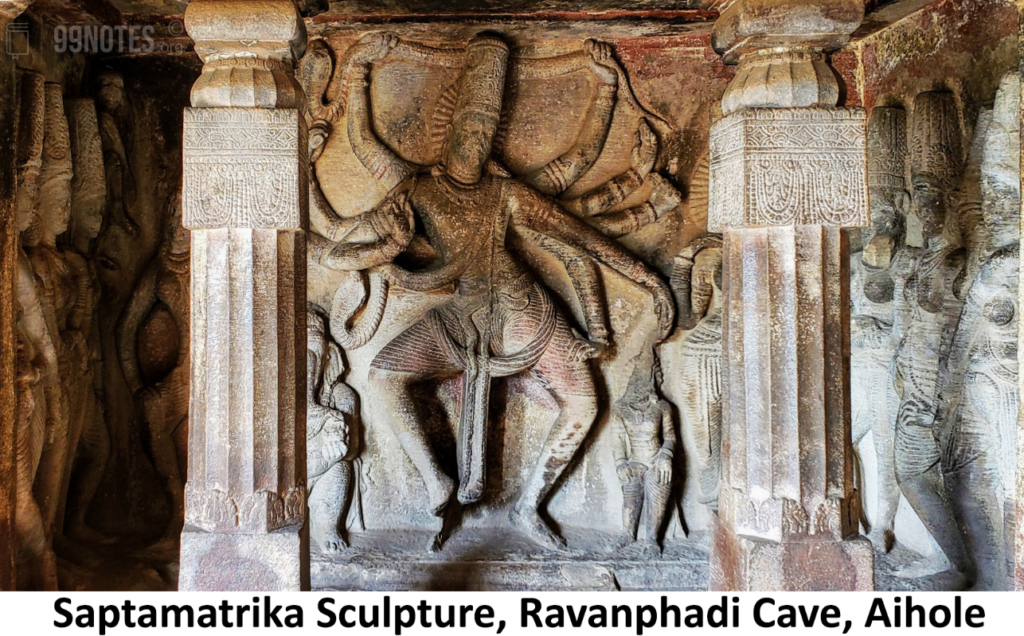
-
-
- Chalukyan Administration
- King – was the source of all authority. He assumed high-sounding titles such as Maharaja, Dharmamaharajadhiraja, Bhattaraka etc.
- In the beginning, kingship was based on Vedic ideals. However, during this period, Vedic sacrifices gradually lost their social significance.
- Nevertheless, their political relevance continued, as is clear from the number of Ashvamedha sacrifices.
- Taxation: The land tax of nearly one-sixth or more of the produce was the principal tax, in addition to several other taxes such as those on weavers, draught cattle, marriage parties etc.
- Administrative Units: The kingdom was organised into a hierarchy of administrative divisions.
- In the Deccan, these units were called Vishaya, Ahara, Rashtra, etc.
- From the 8th century C.E, there emerged a trend in the Deccan of organising kingdoms into a hierarchy of multiples of ten villages.
- In the Deccan, the role of assemblies and local associations was not clearly defined. In place of corporate institutions, it was mahajanas who took part in local administration in villages and towns in Chalukyan times.
- In villages, the mahajanas had a leader called Gavunda (headman). They did not enjoy the same kind of autonomy as was the case with south Indian assemblies but were closely supervised by state officials.
-
The Pallavas
-
-
- The rise of Pallavas started with Simhavishnu in the middle of the 6th century CE. He routed the Kalabhras in Tandaimandalam (Kanchi Region) and expanded his kingdom southward up to the Kaveri delta.
- The word Pallava means creeper and is a Sanskrit version of Tamil Tondai.
- The authority of Pallavas extended from southern Andhra to northern Tamil Nadu.
- They established their capital at Kanchipuram, which became a town of temples and Vedic learning.
- Mahendravarman-I (600 AD – 630 AD)
- Mahendravarman-I succeeded Simhavishnu. He annexed regions in the north up to the river Krishna and subjugated the neighbouring chieftains. In his time, Pallavas reached the sphere of influence of the Badami Chalukyas and the Pandyas.
- He took the titles like Chitrakarapuli (tiger among the painters) and Vichitrachitta (curious-minded).
- He was defeated by Pulakesin II and had to submit his northern territories.
- Narshimhavarman I (630-668 CE)
- He is considered the greatest Pallava ruler and took the title of Mamalla (great warrior).
- He took revenge for his father’s defeat and probably killed the Chalukyan ruler Pulakesin II in 642CE. He destroyed the Chalukyan capital Vatapi and assumed the title Vatapikonda (conqueror of Vatapi) to commemorate this remarkable victory.
- He invaded Ceylon (Sri Lanka) twice to help Manavamma, an exiled Ceylonese prince who sought his support in securing the throne of Ceylon.
- The city of Mamallapuram, or Mahabalipuram, was founded by him.
- In 642 CE, the Chinese Pilgrim Hieun Tsang visited Kanchipuram during his reign.
-
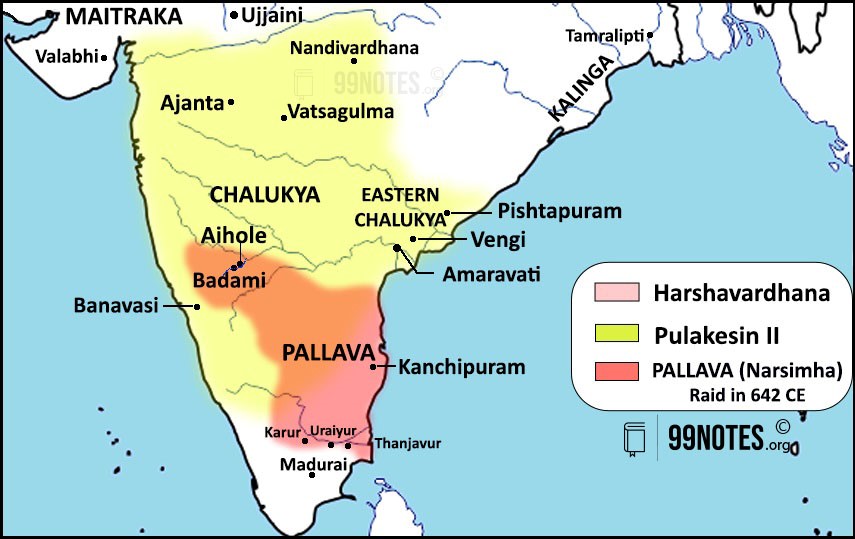
-
-
- Later rulers:
- Mahendravarman II (668-670 CE) was killed by the Chalukyan king Vikramaditya I with the assistance of the western Ganga emperor.
- Parmesvaravarman I (670-690 CE)
- He defeated the Chalukyas and negotiated peace by returning their territories. In return, he enjoyed a yearly tribute from the Chalukyas.
- To commemorate his victory over the Chalukyas, he assumed titles such as ‘Ugradanda’, one ruling with an iron rod and “the destroyer of the city of Ranarasika”. Ranarasika (lover of war) was the title adopted by Chalukyan emperor Vikramaditya I.
- Nandivarman II(731-795)
- He became ruler at the age of 12. This time the Pallava capital Kanchipuram was occupied and, for a brief period, came under Chalukya rule.
- During his reign, Pallava power declined considerably.
- Pallava continued to exist as a minor power for a century, after which Aparajita, the last imperial Pallava, lost to the Imperial Cholas.
- Pallava Administration:
- In the Pallava kingdom, the Nadu was the main unit of administration.
- In south India, especially under Pallava, the local corporate units played an important role in people’s lives.
- There were many local groups and associations based on caste, craft, profession or religious persuasion, such as an association of merchants like the Nanadesis, the Manigramam etc.
- Besides that, there were three important territorial assemblies:
- Ur was a non-Brahmanical village assembly.
- Sabha was a village assembly consisting only of Brahmanas.
- Nagaram was an assembly where mercantile interests predominated.
- During the late Pallava period, the sabha developed a system of governance through committees (variyam system). It became a hallmark of self-government in the brahmana settlements in south India.
- Later rulers:
-
Religion and Temples
-
-
- Worship of the Hindu trinity, Brahma, Vishnu and Shiva, especially of the last two, was getting popular, besides the performance of Vedic sacrifices.
- From the seventh century onwards, the Bhakti cult started dominating the religious life of south Indians, and Alvars (devotees of Vishnu) and Nayanars (devotees of Shiva) played a great part in propagating it.
- The Pallava kings constructed several stone temples in the seventh and eighth centuries. The most famous example is the seven ratha temple at Mahabalipuram, built by Narsimhavaraman.
- Mahabalipuram is also famous for the Shore temple, a structural construction, unlike the seven ratha, which was rock cut.
-
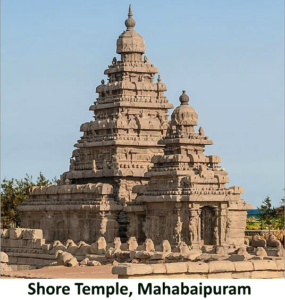
-
-
- Pallavas also constructed several structural temples at their capital Kanchi like the Kailashnath temple.
- Chalukyas of Badami also built several temples at Aihole and adjacent towns of Badami and Pattadakal. The most famous temples in Pattadakal arethe Papanatha temple andthe Virupaksha temple.
- These temples may have been maintained through the land grants given to them, which had become a common phenomenon in south India after the eighth century.
-
Social structure
-
-
- Society was dominated by priests and princes, who claimed the status of brahmins and Kshatriyas. The priests invented respectable family trees for the chiefs and traced their descent from the ancient solar and lunar dynasties.
- In this phase, priests gained influence and authority because of land grants.
- After priests and princes came the peasants, who were divided into numerous castes and were considered Shudras by the Brahmanical system.
- If the peasant and artisan class failed in their duties, it was considered a departure from Dharma, and it was the duty of a king to restore Dharma or the social order. The title of dharma-maharaja, therefore, was assumed by the Vakataka, Pallava, Western Gangas and Kadamba kings.
-
Agriculture
-
- The Kings of this era realised the importance of agriculture, which formed a significant source of their revenue. As a result, the state did everything it could to promote the expansion of agriculture.
- It is significant that Nadu, the basic administrative division in Pallava (and later in Chola) times, also meant arable land.
- In tribal regions, the Brahmanas were granted land. The tribal peasantry, too, adopted better methods of agriculture and learned the value of preserving cattle. King Mayurasarman of the Kadamba dynasty is said to have brought a large area of land into Agriculture by inviting Brahmanas from afar.
- Moreover, as agriculture depended majorly on irrigation in south India, the Pallava rulers took great interest in providing and maintaining canals, tanks, lakes and large wells.
- It appears that the state made great demands on the labour and production of the peasantry in these kingdoms for carrying out wars, promoting religion, maintaining administrative staff etc.
- Besides tax, the king could ask for benevolent offerings in the form of cereals, gold, wood, grass, milk etc.
- The peasantry was also supposed to take care of royal officials who would visit villages. During the march of armies, the rural communities had to perform several obligations.
- However, Brahmanas were granted immunities from performing most of these obligations.







